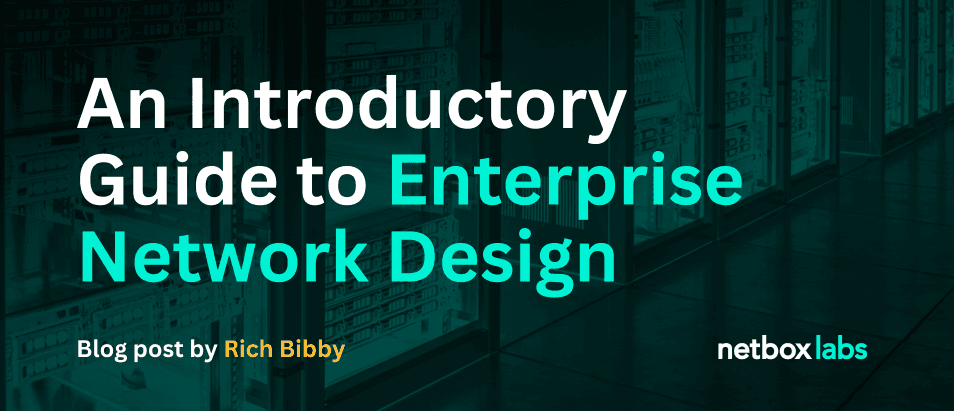An Introductory Guide to Enterprise Network Design


In today’s highly connected world, efficient network design is critical for maintaining the smooth operation of businesses of all sizes. Proper network design ensures that data flows securely and efficiently across devices, applications, and locations, enhancing performance and minimizing downtime. With the increasing complexity of networks, understanding the principles of network design has become essential for engineers and organizations alike.
In this post, we’ll explore the fundamentals of network design, including the different types of networks; key principles such as scalability, reliability, performance, and security; and best practices to optimize your network infrastructure. We’ll also discuss network design models, topologies, hardware and software considerations, and tools that can assist in the design process—highlighting how solutions like NetBox can serve as valuable resources.
What Is Network Design?
Network design is the process of planning and creating the physical and logical frameworks of a network to ensure alignment with an organization’s goals and adaptability to future needs. The physical design involves selecting hardware such as routers, switches, and cables, while the logical design includes determining IP addressing schemes, network segmentation, and security protocols.
Network design engineers are responsible for this process. By using network design tools like NetBox, you can accurately document these components, ensuring that both the physical and logical layers are consistently aligned. Whether designing a small office LAN or a complex cloud-based architecture, this alignment is critical to the success of the network.
Overview of Network Types
Before diving into the principles of network design, it’s important to understand some of the different types of networks that engineers most commonly design:
- local area networks (LANs) that cover a small geographic area, typically within a building or campus
- wide area networks (WANs) that span cities, regions, or even countries
- cloud networks that leverage cloud services to store data and run applications remotely
Fundamental Principles of Network Design
Having understood what network design entails and the various types of networks, it’s crucial to be aware of the core principles that ensure a network’s effectiveness and longevity. This section will go through these fundamental concepts, which serve as the foundation for creating robust and efficient network infrastructures.
Scalability
A well-designed network must be able to grow without requiring major overhauls. As organizations evolve, they may add devices, increase bandwidth requirements, or expand to new locations. Planning for future growth allows for seamless scaling when new infrastructure is added, saving time and resources in the long run.
Reliability and Redundancy
To ensure that a network remains operational in case of failures, incorporating redundancy is essential. Backup paths and devices guarantee that services remain available even if a primary component fails. Documenting these redundancies helps maintain a high level of service availability and facilitates quicker recovery during outages.
Performance
Designing for performance means ensuring that the network can handle the required data loads efficiently. Factors like bandwidth, latency, and packet loss are critical considerations. Utilizing network design tools to visualize network capacity and device roles can help ensure that the network meets performance targets and can handle peak traffic demands.
Security
Security must be integrated into the network design from the outset. This includes implementing firewalls, intrusion detection systems (IDS), and encrypting data both at rest and in transit. Mapping out security zones, defining device roles, and setting access permissions are crucial steps in maintaining a secure network infrastructure and verifying that security policies are effectively enforced.
Network Design Models
Now that we’ve explored the fundamental principles of network design, let’s examine how these principles are applied through various network design models. These models provide a structured approach to creating networks and can be tailored to different types of networks. To illustrate this, we’ll delve into how these models are implemented when designing LANs and WANs.
Designing Local Area Networks (LANs)
LAN design focuses on maximizing performance within a limited area, such as an office building. Engineers can model the placement of switches, wireless access points, and other equipment to optimize bandwidth and ensure coverage in all necessary locations.
Designing Wide Area Networks (WANs)
WANs connect multiple sites over large geographic areas. The design must take into account bandwidth constraints, latency, and the cost of long-distance connections. It’s important to visualize and document WAN links, ensuring that backup links and redundancy are incorporated into the design using appropriate tools.
Network Topologies
Network topology refers to the physical or logical arrangement of devices and connections in a network. Popular topologies include
- star topology, where devices are connected to a central switch or hub;
- mesh topology, where devices are interconnected, providing multiple paths for data transmission; and
- bus topology, where devices share a single communication line.
Understanding these topologies is essential because the chosen topology can significantly impact a network’s performance, scalability, and reliability. Each topology has its own set of advantages and drawbacks.
For instance, star topology simplifies management and troubleshooting but introduces a single point of failure at the central hub.
Mesh topology offers high redundancy and fault tolerance due to multiple data paths but can be complex and costly to implement.
Bus topology is cost-effective and easy to set up for small networks but can suffer from performance issues as more devices are added and is less reliable due to the shared communication line.
Selecting the appropriate topology involves balancing these factors to meet the specific needs and resources of the organization. With NetBox’s topology maps, engineers can visualize and simulate changes, making it easier to plan, troubleshoot, and maintain complex topologies such as mesh networks or hybrid environments. This example shows how NetBox can be located in the network architecture.
Network Hardware and Software
Having examined how devices are arranged within different network topologies, the next step is to focus on the hardware and software components that make up these networks. Understanding the roles of various devices and applications is essential for implementing an effective and manageable network infrastructure.
Types of Devices
Devices like routers, switches, firewalls, and wireless access points form the backbone of any network. Each device plays a unique role in routing, filtering, or transmitting data. Network design tools simplify the management of these devices by providing a centralized platform to track their roles, interfaces, and connections. Engineers can model device relationships and monitor the health of their infrastructure.
Network Management Software
Effective network management requires visibility into the design and configuration of network elements. Network management software provides administrators with tools to monitor network performance, configure devices remotely, and troubleshoot issues proactively. These solutions help in optimizing network operations by offering insights into traffic patterns, device statuses, and potential security vulnerabilities.
NetBox’s role as a “single source of truth” allows network engineers to manage their infrastructure efficiently, focusing on the intended state rather than the observed, real-time state. In combination with network automation tools like Ansible or Nornir, NetBox can help automate routine configuration tasks.
Network Security Tools
To keep networks secure, engineers use various security tools such as firewalls, VPNs, and IDS. These tools can be integrated into network design tools in order to document security zones, ensuring that the designed state aligns with security policies.
Network Design for Cloud Computing
As organizations migrate to the cloud, network designs must integrate with cloud infrastructure. Hybrid networks that connect on-premises environments with cloud services must be carefully planned for scalability, security, and performance. NetBox has the ability to document both physical and virtual resources, providing a clear view of the network infrastructure and making it indispensable for modern cloud-network hybrid solutions.
Features of Network Design Solutions
When choosing a network design solution, key features to look for include the following:
- Visualization: The selected tools should provide a graphical interface to visualize device interconnections and network topology. This visual clarity helps network engineers identify potential issues and optimize the design more effectively.
- Automation: Automating configuration tasks is vital to scaling the network efficiently and reducing the risk of human error. A robust network design tool should support automation to streamline deployments and ensure consistency across the infrastructure.
- Documentation: Comprehensive documentation of the network design is crucial, as it serves as a reference for both day-to-day maintenance and future network expansion. Furthermore, a good network design tool should make it easy to track both physical and logical components, ensuring you have accurate information readily available for updates or troubleshooting.
Best Practices for Network Design
With a solid understanding of network design principles, models, and topologies, it’s important to apply this knowledge through best practices that enhance the effectiveness and reliability of your network. In this section, we’ll discuss key strategies to optimize your network infrastructure.
Plan for Scalability
Designing with future growth in mind ensures that your network can expand as business needs evolve. By anticipating additional users, devices, and increased traffic, you can avoid costly redesigns. Moreover, NetBox assists with planning by documenting the current network infrastructure and providing insights for seamless expansion, such as adding new devices or network segments.
Ensure Redundancy
Redundancy is key to minimizing downtime in the event of failures. By incorporating backup paths and redundant hardware, you ensure that if one component fails, another can take over. Additionally, NetBox tracks these redundant links, providing visibility into failover mechanisms to keep the network operational during outages.
Monitor Performance
To maintain optimal network performance, it’s essential to monitor traffic and ensure the design can handle expected data loads. Regularly reviewing performance metrics like bandwidth usage and latency helps identify potential bottlenecks. Network capacity insights provided by NetBox assists the network engineers in planning performance improvements when needed.
Prioritize Security
Integrate security from the outset of the network design process. Implement firewalls, encryption, and network segmentation to protect data and ensure compliance with security policies. Engineers map and document security zones to ensure proper configuration of devices and access control mechanisms.
Use Documentation Tools
Keeping detailed and up-to-date documentation is crucial for troubleshooting and future upgrades. NetBox serves as a centralized source of truth, ensuring that network designs remain consistent with actual configurations.
Conclusion
Network design is a crucial aspect of creating efficient, secure, and scalable infrastructures. Throughout this post, we’ve explored the fundamentals of network design, including key principles like scalability, reliability, performance, and security. We also discussed various network types, design models, topologies, and the importance of hardware and software components. By applying best practices and leveraging tools like NetBox, network engineers can design robust networks tailored to different environments, ensuring they meet organizational goals and adapt to future needs.
Whether you’re working on a LAN or WAN or integrating cloud services, understanding these core concepts is essential. Implementing effective network design not only enhances current operations but also positions your organization for future growth and technological advancements.
For more insights on network design and best practices, subscribe to our newsletter.
